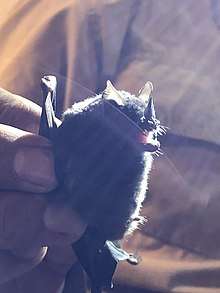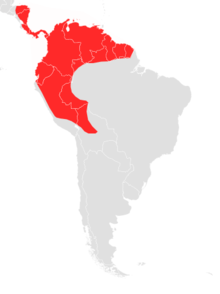Chestnut short-tailed bat
The chestnut short-tailed bat (Carollia castanea) is a bat species from South and Central America. The species is often confused with the Benkeith's short-tailed bat. It is a mainly frugivorous species that has been known to consume insects (its favorite food being piperaceae).[2] To determine which pipers to forage on, it focuses on oder and then after proceeds to echolocate to determine position.[3] It hunts between nightfall and midnight (females during the first half, males during the whole). Habitats include hollow trees, caves, cracks, abandoned mines, sewers, and house roofs. It does not decrease activity during full moons, only instances of turbulent weather like heavy rain.[2][4] In an agricultural setting it has a higher resistance to habitat fragmentation compared to similar bat species.[5]
| Chestnut short-tailed bat | |
|---|---|
 | |
| Scientific classification | |
| Kingdom: | Animalia |
| Phylum: | Chordata |
| Class: | Mammalia |
| Order: | Chiroptera |
| Family: | Phyllostomidae |
| Genus: | Carollia |
| Species: | C. castanea |
| Binomial name | |
| Carollia castanea Allen, 1890 | |
 | |
| Chestnut short-tailed bat range | |
Gallery
 Chestnut short-tailed bat (Juvenile Male)
Chestnut short-tailed bat (Juvenile Male)_teeth.jpg) Chestnut short-tailed bat Teeth (Juvenile Male)
Chestnut short-tailed bat Teeth (Juvenile Male)
References
- Solari, S. (2016). "Carollia castanea". The IUCN Red List of Threatened Species. 2016: e.T88110411A88110432. doi:10.2305/IUCN.UK.2016-1.RLTS.T88110411A88110432.en.
- Schnitzler, Hans-Ulrich; Kalko, Elisabeth K. V.; Thies, Wibke (2006-04-21). "Influence of Environment and Resource Availability on Activity Patterns of Carollia castanea (Phyllostomidae) in Panama". Journal of Mammalogy. 87 (2): 331–338. doi:10.1644/05-MAMM-A-161R1.1. ISSN 0022-2372.
- Thies, Wibke (June 1998). "The roles of echolocation and olfaction in two Neotropical fruit-eating bats, Carollia perspicillata and C. castanea, feeding on Piper". Behavioral Ecology and Sociobiology. 42 (6): 397–409. doi:10.1007/s002650050454.
- "Mamíferos del Ecuador". bioweb.bio. Retrieved 2019-09-09.
- Ripperger, Simon P.; Tschapka, Marco; Kalko, Elisabeth K. V.; Rodríguez-Herrera, Bernal; Mayer, Frieder (2014-03-01). "Resisting habitat fragmentation: High genetic connectivity among populations of the frugivorous bat Carollia castanea in an agricultural landscape". Agriculture, Ecosystems & Environment. 185: 9–15. doi:10.1016/j.agee.2013.12.006. ISSN 0167-8809.
